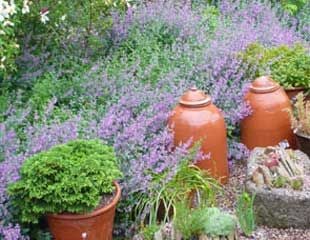
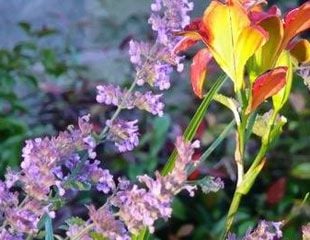
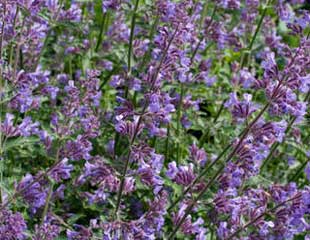
How to grow Nepeta common name Cat Mint
Nepeta is a much underrated lovely summer flowering perennial which is so easy to grow.
I think it gets overlooked because of its common name, Cat Mint. I would say really, don't let that put you off. Nepeta is very hardy, easy to grow because it is tolerant of most growing conditions and it returns reliably each year . The fact that Nepeta is tolerant of most growing conditions, including partial shade, dry and drought areas, makes it useful for tough spots in the garden.
If you are looking for soft blues in your garden, Nepeta will tolerate wet conditions which Lavender will not. Lavender is a Mediterranean plant. It needs dry, well-drained soil and sun; contrast Catmint, which will grow almost anywhere. Nepeta is native to a number of habitats, from cool and moist to hot and dry and so will grow in a range of habitats. Catmint will grow in sun or partial shade and in both moist and dry soils. It is very tough, almost a grow anywhere plant. The only conditions it will resent is really boggy ground. It is also long flowering and after cutting back, will produce a second flush of flowers.
Plus, the bees love it.
Walk past a clump of Nepeta on a warm day and it will be buzzing with the sound of bees. Low maintenance, it positively does not need feeding, which can make it leggy. Apart from bees, as its name suggests, it is attractive to cats who love it. If you are not a cat lover and don't want sections of your plant rolled on, insert a few sticks, ( which can double as plant supports. ) The plant growth will conceal them and deter cats from taking a roll in the Nepeta. If you like cats, you may just want to sit by and watch them go bonkers for the cat mint, making a beeline for it and rolling about.
When and how to Cut back and prune Nepeta
You can cut back Nepeta at four different times.
Nepeta is a woody deciduous perennial. In early spring, before the new growth starts in earnest, cut off all of last year's growth and this year's growth will come through.
In May you can Chelsea Chop it especially the large varieties such as Nepeta faassenii 'Six Hills Giant', which can sprawl and can go thin in the middle. To avoid this, Catmint responds well to the Chelsea Chop. In late May, cut catmint back by about a third. This will delay flowering slightly and make for a more compact shrub.
You can also cut back Nepeta after flowering, and when doing so, if you look carefully at the plant you will see newer growth which foliage has a fresh look, (greener,) contrasted against the tired older foliage, (more yellow.) Cut back the old foliage, let new growth through and it will produce a smaller late flush of flowers, especially in a good summer.
The intensity of the blue fades after flowering and its worth shearing off the dead heads as it will often throw up some new flower shoots.
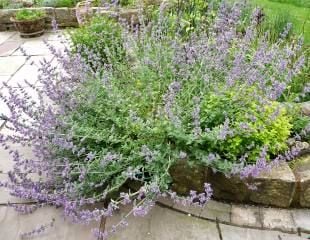


Ideas about nepeta
If your problem with Nepeta is that it usually sprawls, as in the image, it is definitely a candidate for the Chelsea Chop. It is not really mysterious, just a form of pre flowering prune to make the shrub bushier. Check out How to do the Chelsea Chop and video.
Are you not so keen on the shape of it?
Check out a trailing form Nepeta hederacea 'Variegata'. Variegated, fully hardy, it has delicate creamy green scalloped leaves and purple flowers in early summer. Often sold to compliment bedding plants in hanging baskets, it is in fact a hardy perennial and you can save it from year to year. At the end of the season when you disassemble the hanging basket, take out the Nepeta, cut it back to around 15cms and pot up.
The other shape/form of Nepeta is a tall upright variety called Nepeta parnassica. It grows to around 1m, is a strong blue and grows upright, making a well-formed shrub.
Some More Varieties of Nepta to Grow
Nepeta is N. Six Hills Giant and Walkers Low are very often on sale. They are both tall varieties which can reach 90cms, (3ft). The drawback is because of their size, there is a tendency for the plant to sprawl and it needs staking to reduce this. I think some of the compact varieties are better, and need less maintenance. If you are looking to plant Nepeta take a look at some of these varieties:
N fassenii has the AGM with pale lavender flowers and grows up to around 45cms (18") Also, a very lovely blue is Nepeta faassenii 'Purrsian Blue'
Nepeta nervosa 'Blue Moon', is compact, up to 40cms with strong blue flowers and Nepeta nervosa 'Pink Cat' similar but with pink flowers.
I like Nepeta Neptune compact, see below, growing only to around .3m and a soft blue.
Another soft blue is N. racemosa 'Walkers Low' similar to Six Hills Giant except smaller growing to 60 cms (2ft)
N. racemosa 'Snowflake' as the name suggests has white flowers.
The problem with all the taller Nepeta is the tendency to sprawl and flop. However, there is one Nepeta which has a strong upright form and needs no staking even though it will reach up to 2m. Nepeta parnassica is native to Greece, upright, clump forming with strong blue/lilac flowers. It shares all the other characteristics of Nepeta, save flowering a little later in the summer.
The long and the short of it.

Left is Nepeta Neptune compact, which only grows up to .3m.Ideal for the front of a border or a rockery.
Contrast with N. parnassica which grows to 1.8m tall and is unique amongst tall varieties for its upright form. This image really does not do it justice, as such a tall upright Nepeta was impressive. This image of Nepeta parnassica was taken at Arley Hall .
Plants that look good with Nepeta - Cat Mint
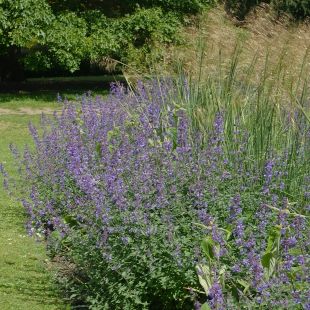
Nepeta is every garden plant's friend, as it looks good with such a wide range of plants and planting schemes. It has an affinity with grasses. I took this image at Cambridge Botanic Gardens ( a great place to visit) where Nepeta was widely planted. It also sits well with many other garden perennials.
Nepeta also looks good with Hemerocallis (Day Lilly) above centre image and contrasts well with Alchemilla (lady's Mantle,)image below right. Nepeta blends well with silver leaved plants. It is also good as repeat planting throughout a border, shown in the image top left taken at Birmingham Botanical Garden where Nepeta was used to good effect in many parts of the garden.
Last point of interest with regard to Nepeta.
There is a variety commonly used in hanging baskets, Nepeta glechoma 'Variegata', N hederacea also known as variegated ground ivy. It has delicate mauve flowers early in the year, see centre image below. This variety is universally used in summer bedding arrangements trailing down from hanging baskets and tubs. In fact, it is fully hardy and can be overwintered, saving money on next year's garden budget.
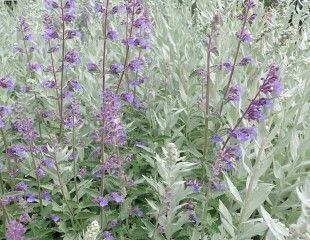
Silver Planting combination Nepeta and Artemisia
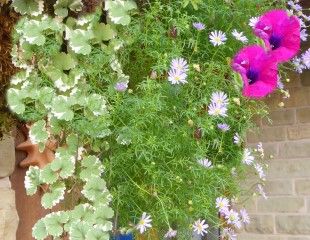
N.hederaces 'Variegata' used in bedding
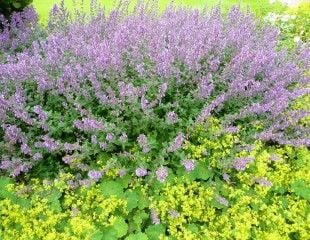
Soft blue Nepeta combined with frothy lime green Alchemilla

Catmint it is a much under-estimated plant, with lovely aromatic foliage, with spikes of soft blue flowers.

